Hoi An Ancient Town is a charming and historic area in central Vietnam. Known for its well-preserved architecture, this UNESCO World Heritage Site features a mix of Vietnamese, Chinese, and Japanese influences. The town’s narrow streets are lined with old houses, temples, and shops, making it a picturesque destination. Famous for its lantern-lit evenings, Hoi An Ancient Town offers a magical atmosphere that attracts visitors worldwide.
Where is Hoi An Ancient Town?
Hoi An Ancient Town, nestled in central Vietnam, lies adjacent to the coastline, approximately 30 kilometers south of Da Nang City. This strategic location facilitated its prominence as a bustling trading port during the 15th to 19th centuries, connecting various cultures and goods across Asia and Europe. The town’s proximity to the Thu Bon River further enhanced its role in maritime trade, contributing to its cultural diversity and architectural heritage that we admire today.
History of Hoi An Ancient Town
Hoi An Ancient Town in Vietnam has a fascinating history as a busy trading port from the 15th to the 19th century. Merchants from around the world traded silk, spices, ceramics, and more here. Located by the Thu Bon River, Hoi An connected Southeast Asia with China, Japan, India, and Europe, bringing wealth and cultural diversity to the town. Its mix of Chinese temples and Japanese merchant houses reflects this rich heritage.
Today, Hoi An’s well-preserved buildings and streets tell its vibrant story, leading to its recognition as a UNESCO World Heritage Site. This status ensures that Hoi An’s ancient treasures are protected and that visitors can learn about its past as a bustling trading hub.
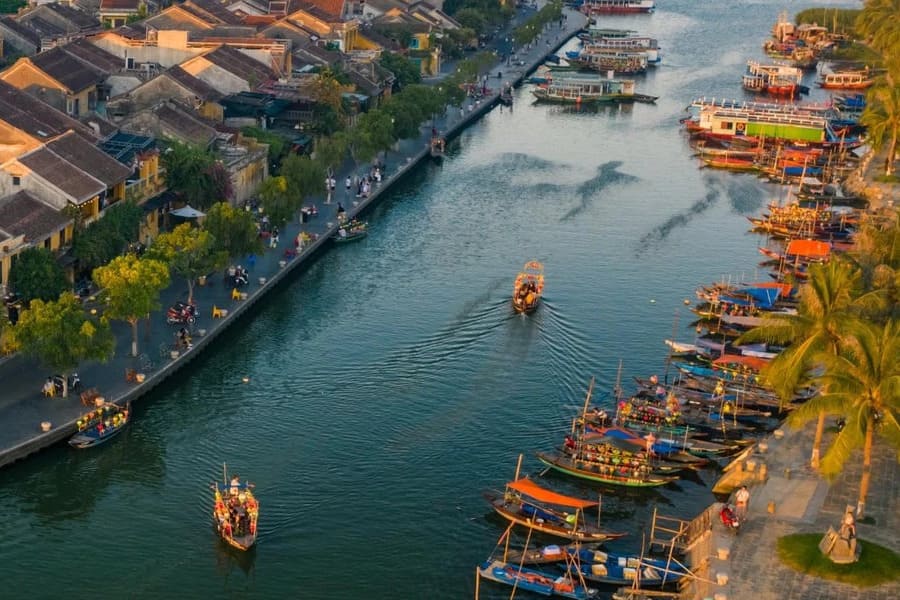
Immerse yourself in the unique architecture of Hoi An Ancient Town
Japanese Covered Bridge – the symbol of Hoi An Ancient Town
The Japanese Covered Bridge, locally known as Cau Chua, is a significant symbol in Hoi An Ancient Town, in Vietnam. Built in the early 17th century by the Japanese community, it originally linked their settlement with the Chinese quarters.
Despite its name, the bridge is not a temple but features a small shrine honoring the Taoist deity Tran Vo Bac De, believed to protect against disasters. Its design, inspired by Japanese folklore of controlling the water monster Mamazu, symbolizes protection from flooding, a common challenge for Hoi An along the Thu Bon River.
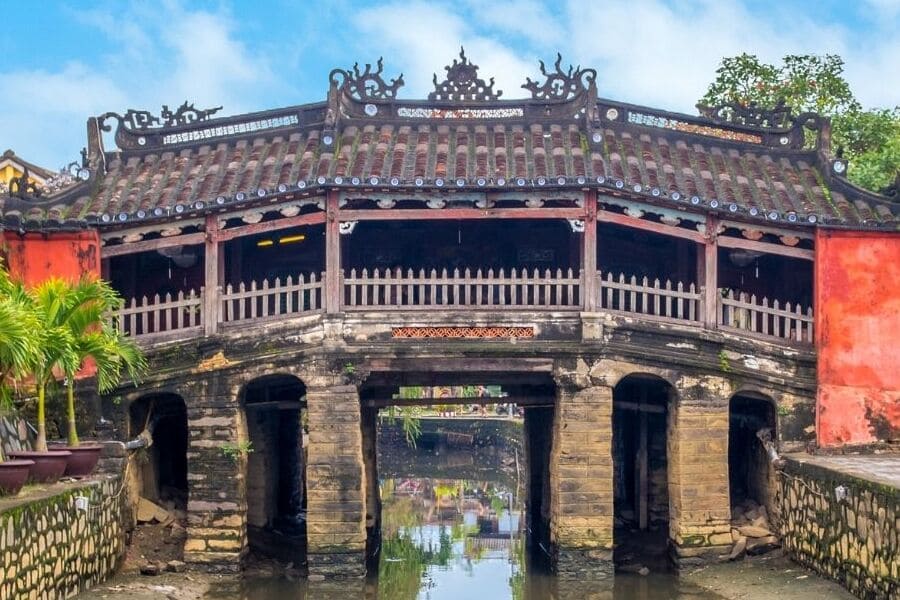
Fujian Assembly Hall in Hoi An
The Chinese Assembly Halls in Hoi An Ancient Town are important cultural and community centers built by different Chinese ethnic groups. One notable hall is the Assembly Hall of the Fujian Chinese Congregation. It was constructed in the late 17th century by Fujian merchants from China.
These halls served as gathering places for Chinese communities to worship ancestors, hold meetings, and celebrate cultural festivals. Each hall is beautifully decorated with intricate carvings, statues, and colorful tilework that reflect the cultural heritage of its founders.
They are also known for their tranquil courtyards and ornate gates, offering a glimpse into the rich history and traditions of the Chinese community on Hoi An shore excursions. Today, visitors can explore these assembly halls to learn about their significance and admire their architectural beauty.
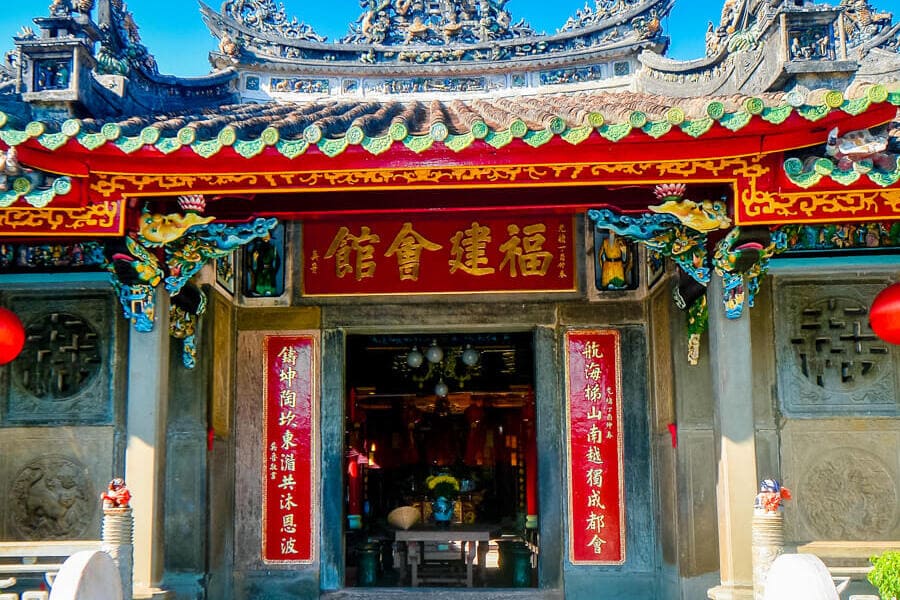
The unique architecture of Hoi An Ancient Houses
The Ancient Houses of Hoi An Ancient Town are historic buildings that glimpse the town’s past. Famous examples include Tan Ky and Phung Hung houses.
Tan Ky House is over 200 years old and showcases a blend of Vietnamese, Japanese, and Chinese architectural styles. It belonged to a prosperous merchant family and served as both a residence and a place of business. Tan Ky House highlights intricate wood carvings, furniture, and a courtyard designed to manage flooding, reflecting the town’s trading and cultural connections.
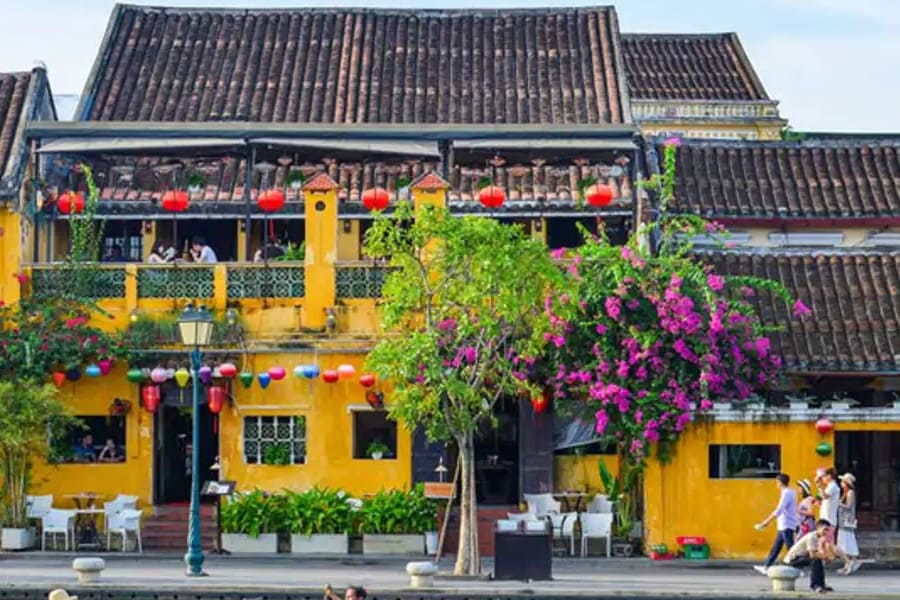
Phung Hung House was built in the late 18th century, Phung Hung House is notable for its well-preserved architecture and historical artifacts. It belonged to a prominent Vietnamese trader and had elements influenced by Chinese and Japanese design. The house is a testament to Hoi An’s economic prosperity during its trading peak, displaying ornate furnishings, traditional art, and a strategic layout that emphasizes harmony with nature.
These Ancient Houses not only preserve architectural styles from different cultures but also serve as important cultural landmarks. They offer insights into Hoi An’s role as a thriving trading port and its cultural exchange with neighboring countries during past centuries. Today, they are cherished heritage sites that attract visitors interested in history, architecture, and cultural diversity.
Explore a tapestry of cultures in Hoi An Ancient Town
Traditional handicrafts of Hoi An
In Hoi An Ancient Town, traditional crafts are an integral part of its cultural heritage. Two prominent crafts are lantern making and pottery.
Hoi An is famous for its colorful lanterns, which adorn the town’s streets and riverfront. Local artisans skillfully handcrafted these lanterns using bamboo frames covered with silk or paper. The lanterns come in various shapes, sizes, and vibrant colors, often featuring intricate designs and patterns. Lantern-making workshops allow visitors to experience the craft firsthand, learning about the traditional techniques passed down through generations.
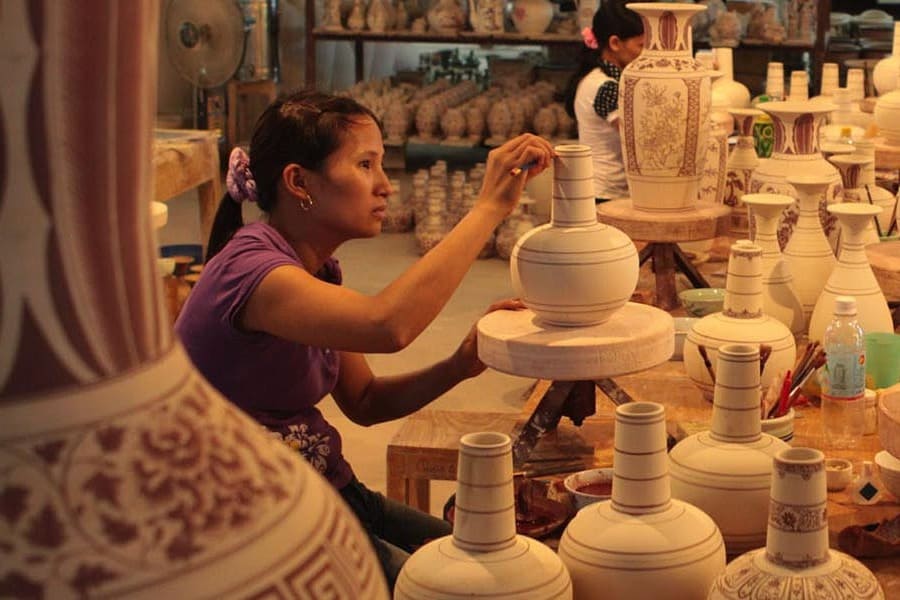
Pottery has been a traditional craft in Hoi An for centuries. Local artisans create pottery using techniques that date back to the town’s prosperous trading era. They shape clay into pots, vases, and other ceramics, often incorporating distinctive designs and glazes influenced by Chinese and Japanese styles. Visitors can visit pottery workshops to observe the artisans at work, try their hand at pottery making, and purchase unique ceramic pieces as souvenirs.
These traditional crafts not only showcase Hoi An’s artistic heritage but also provide opportunities for visitors to engage with local culture and bring home handmade treasures that reflect the town’s charm and craftsmanship.
The colorful and enchanting atmosphere of the Lantern Festival in Hoi An
The Lantern Festival in Hoi An Ancient Town is a magical monthly event celebrated on the 14th day of the lunar calendar. During this festival, the town is adorned with thousands of colorful lanterns, creating a mesmerizing display of lights along the streets and on the Thu Bon River.
The festival holds deep cultural significance as it honors ancestors and spirits while promoting good fortune and happiness. Residents and visitors release lanterns onto the river, each carrying wishes and prayers. Traditional music performances, dance shows, and street food stalls add to the festive atmosphere, offering a delightful experience of Vietnamese culture.
The Lantern Festival not only highlights Hoi An’s historical charm but also showcases its vibrant community spirit and dedication to preserving traditions. It’s a time when locals come together to celebrate their heritage and share the beauty of their town with visitors from around the world.
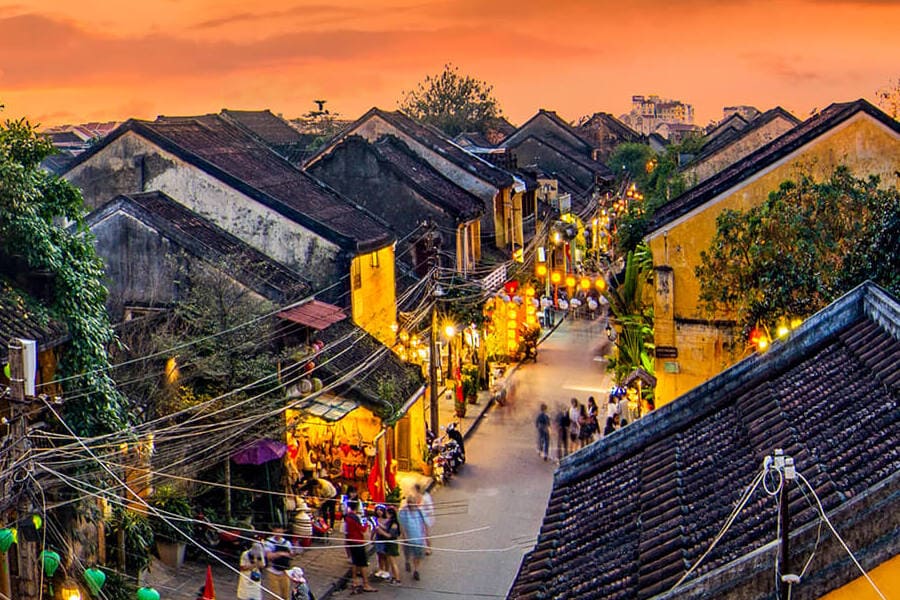
Local performances in Hoi An Ancient Town
In Hoi An Ancient Town, visitors can enjoy traditional music and dance performances that showcase the local culture. These local performances offer visitors a chance to immerse themselves in Hoi An’s cultural traditions, providing memorable insights into the town’s artistic and historical legacy.
Local musicians often perform traditional Vietnamese music using instruments like the đàn bầu (monochord), đàn tranh (zither), and various percussion instruments. These performances feature melodies that evoke the region’s rich musical heritage.
Traditional dance performances in Hoi An include graceful movements that reflect Vietnam’s cultural diversity. These dances often depict stories from folklore or historical events, accompanied by vibrant costumes and rhythmic music.
The distinctive culinary scene in Hoi An Ancient Town
Hoi An Ancient Town is known for its delicious signature dishes that you must try
- Cao Lau features noodles made from rice that are firm and chewy, served with slices of pork, herbs, and crispy croutons. Cao Lầu’s unique flavor comes from the water sourced from ancient Cham wells in Hoi An.
- Banh mi Phuong is Hoi An’s famous Vietnamese baguette sandwich, filled with various ingredients like grilled pork, pâté, herbs, and pickled vegetables. It’s beloved for its crunchy exterior and flavorful fillings.
- White Rose Dumplings: Delicate, translucent dumplings filled with seasoned shrimp or pork, shaped to resemble a white rose. These dumplings are steamed and served with crispy shallots, fish sauce, and herbs.
These dishes reflect the local flavors and cultural influences that make dining in Hoi An an unforgettable experience.
Diverse street food in Hoi An

In Hoi An Ancient Town, the street food scene is vibrant and filled with delicious options. Visitors can explore bustling markets and stalls offering a variety of local specialties. You’ll find popular, iconic street foods like Banh mi (Vietnamese sandwich), Cao Lau (noodles with pork and herbs), and Pho (Vietnamese noodle soup) being served fresh and flavorful by street vendors.
Hoi An’s night markets come alive with food stalls selling grilled seafood, savory pancakes (banh xeo), and fresh spring rolls. These markets offer a lively atmosphere where you can sample authentic Vietnamese flavors.
- Make sure to take advantage of delicacies such as steamed buns, grilled rice paper with toppings, and various sweet treats like sticky rice dumplings and fried rice.
- Exploring the street food of Hoi An Ancient Town is not just about tasting delicious dishes but also experiencing the local culture and culinary traditions that have been passed down through generations.
Unmissable Outdoor Activities in Hoi An Ancient Town
Boat Tour in Hoi An Ancient Town
At Thu Bon River in Hoi An Ancient Town, visitors can enjoy relaxing boat cruises that offer picturesque views of the town.
Tourists can take leisurely boat rides along Thu Bon River, exploring the scenic surroundings of Hoi An. These Hoi An shore excursions often pass by ancient houses, lush greenery, and iconic landmarks like the Japanese Covered Bridge.
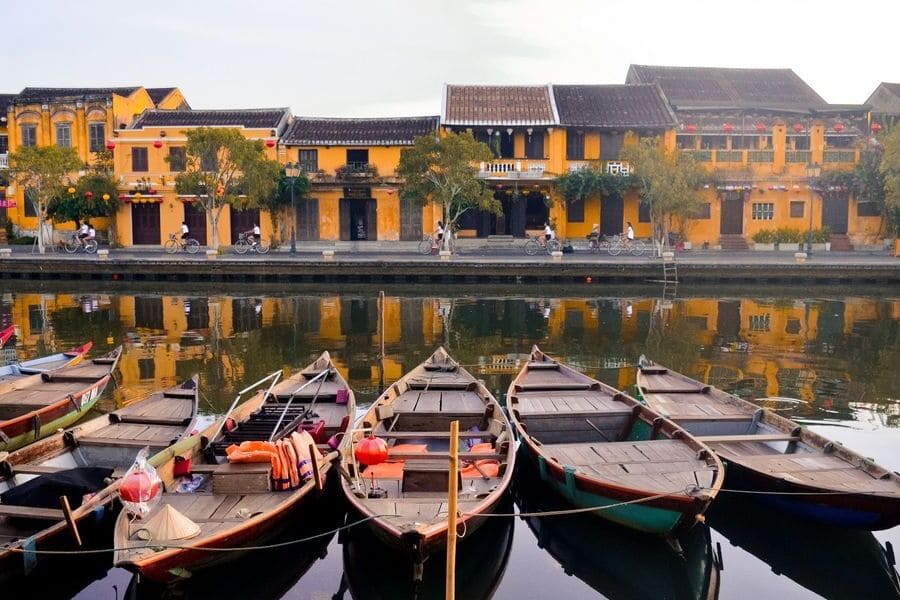
From the river, you can admire Hoi An’s charming architecture reflected in the water, especially beautiful during sunrise or sunset. The cruise offers a peaceful perspective of this UNESCO World Heritage site, showcasing its historic charm and cultural richness.
These boat cruises provide a tranquil escape and a unique way to experience the beauty of Hoi An from a different perspective.
Farm tour at Tra Que Vegetable Village in Hoi An Ancient Town
Tra Que Vegetable Village is a lush and serene place known for its fresh produce and agricultural practices. Tra Que Vegetable Village offers a peaceful retreat from the bustling town of Hoi An, providing insights into local agriculture and culinary traditions amidst beautiful natural surroundings.
Visitors can take guided tours of Tra Que Village to learn about organic farming methods. Local farmers demonstrate how they grow vegetables using traditional techniques, without chemicals.
After the farm tour, tourists often participate in cooking classes where they learn to prepare traditional Vietnamese dishes using fresh ingredients from the village. This hands-on experience allows visitors to appreciate the farm-to-table concept and enjoy authentic flavors.
Beautiful beaches in Hoi An
Hoi An Ancient Town is close to several beautiful beaches, such as An Bang and Cua Dai, which are perfect for relaxation. These beaches near Hoi An Ancient Town provide a peaceful escape and are ideal for unwinding amidst natural beauty and scenic views of the East Vietnam Sea.
Located about 3 km from Hoi An, An Bang Beach offers a tranquil atmosphere with soft white sand and clear blue waters. Visitors can relax under umbrellas, enjoy fresh seafood at beachfront restaurants, or participate in water sports like swimming and surfing.
Situated a short distance from Hoi An, Cua Dai Beach is known for its long stretch of sandy shoreline and gentle waves. It’s a popular spot for sunbathing, beach volleyball, and taking leisurely walks along the coast. Local seafood restaurants provide delicious meals with views of the sea.

Shopping and Souvenirs in Hoi An Ancient Town
Don’t miss the fascinating experiences at the tailor shops in Hoi An Ancient Town
Tailor shops are renowned for their craftsmanship and custom tailoring services, attracting visitors from around the world. Visitors to Hoi An can expect to find a variety of tailor shops lining the streets, each showcasing their craftsmanship and offering a memorable shopping experience. Whether looking for formal attire or casual wear, Hoi An’s tailor shops provide excellent quality and value for money.
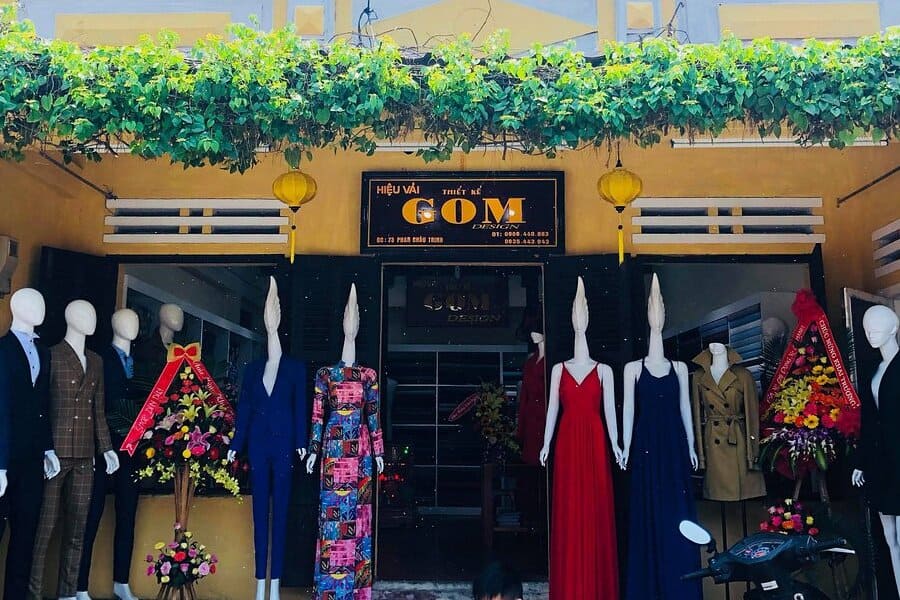
Hoi An is famous for its tailor shops, which offer a wide range of services from traditional Vietnamese ao dai to modern suits and dresses. The town’s reputation as a tailor hub has grown due to its skilled artisans and competitive prices.
Tailors in Hoi An are known for their attention to detail and ability to create garments that fit perfectly. They use high-quality fabrics and offer a personalized experience where customers can choose designs, materials, and styles tailored to their preferences.
You can find unique souvenirs in Hoi An Ancient Town
Colorful lanterns crafted from silk or paper, adorned with intricate designs, are a signature of Hoi An. They add a festive charm to any space and are a popular choice for visitors.
Hoi An is known for its high-quality silk products, including clothing, scarves, and accessories. The silk is often dyed with natural colors and woven into beautiful patterns, making it a luxurious souvenir to take home.
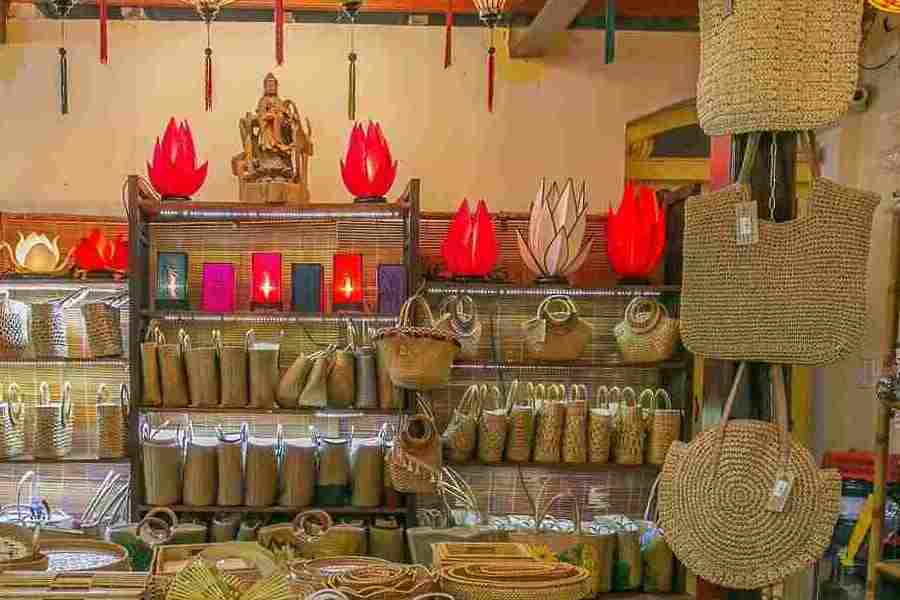
Local artisans in Hoi An create exquisite ceramics such as bowls, vases, and decorative items. These ceramics showcase traditional Vietnamese designs and craftsmanship, offering unique pieces to commemorate your visit.
These souvenirs not only make wonderful gifts but also allow you to bring a piece of Hoi An’s cultural heritage and craftsmanship back home with you.
When is the best time to travel to Hoi An Ancient Town?
The best time to visit Hoi An Ancient Town is from February to April and from September to November. During these months, the weather is generally mild and pleasant, with less rain and lower humidity compared to the summer months. This makes it comfortable to explore the town’s streets, ancient houses, and nearby attractions.
February to April is a great time to visit because you can catch the Lantern Festival, a magical event where the town is lit up with colorful lanterns. Additionally, September to November offers pleasant weather for outdoor activities and exploring local culture without the peak tourist crowds. Visiting Hoi An during these months allows you to enjoy the town’s beauty and cultural events while experiencing favorable weather conditions.
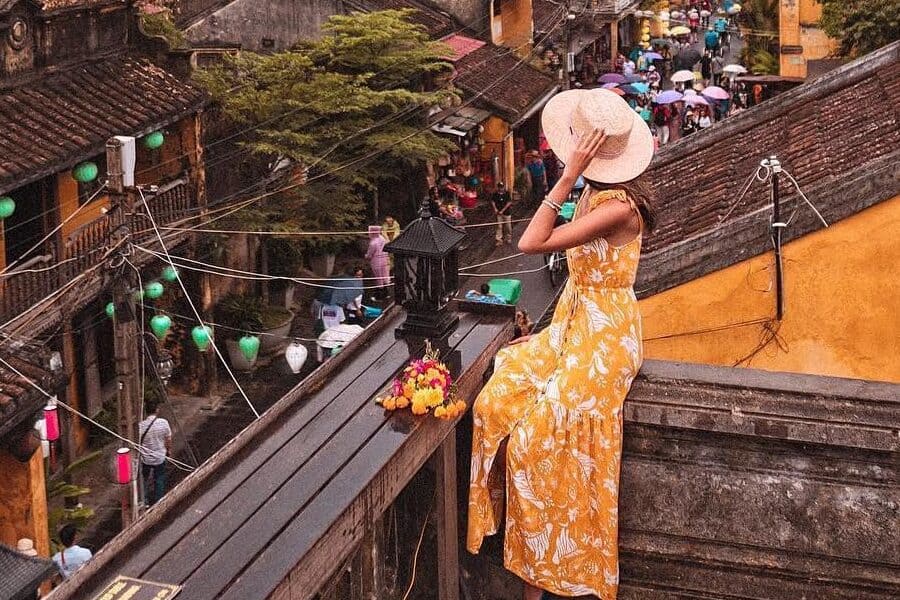
How can you travel to Hoi An Ancient Town?
Getting to Hoi An Ancient Town from Da Nang International Airport is straightforward. You can travel by taxi, shuttle or private transfer, bus, or rent a motorbike or bicycle These options provide flexibility depending on your budget, preference for convenience, and sense of adventure.
Taxis are readily available outside the airport. It’s about a 30-kilometer ride from Da Nang Airport to Hoi An, taking roughly 30-45 minutes depending on traffic. Make sure to agree on the fare before starting the journey.
Many hotels and travel agencies offer shuttle services or private transfers from the airport to Hoi An. This can be arranged in advance through your accommodation or a travel agent.
There’s a local bus that runs between Da Nang and Hoi An. It’s a budget-friendly option but may take longer due to multiple stops.
For the adventurous traveler, you can rent a motorbike or bicycle at the airport and ride to Hoi An. This option gives you flexibility but requires some confidence in navigating Vietnam’s traffic.
Accommodation in Hoi An Ancient Town
They offer a range of options, including boutique hotels and homestays. Both boutique hotels and homestays in Hoi An Ancient Town offer opportunities to immerse yourself in the town’s historic charm and vibrant atmosphere. They are conveniently located near the town’s attractions, allowing for easy exploration on foot or by bicycle.
These are small, stylish hotels that often reflect traditional Vietnamese architecture and decor. Staying in a boutique hotel in Hoi An Ancient Town provides a cozy and personalized experience, with amenities like unique room designs and personalized service.
Homestays allow visitors to stay with local families, providing an authentic insight into Vietnamese culture and daily life. Guests often have their room and may share meals with the host family, fostering a warm and welcoming atmosphere.
Are you ready to visit and experience Hoi An Ancient Town?
Discover the allure of Hoi An Ancient Town wander historic streets, cross ancient Japanese bridges, and soak in the glow of colorful lanterns. Immerse yourself in traditional crafts, indulge in local flavors, and unwind on pristine beaches. Vietnam shore excursions offer additional adventures, from cruising along the Thu Bon River to exploring the lush Tra Que Vegetable Village. Hoi An shore excursions provide the perfect opportunity to delve deeper into the local culture and natural beauty. Don’t forget to join the enchanting Lantern Festival and treat yourself to custom-tailored clothing! Come, uncover the enchantment of Hoi An Ancient Town!


